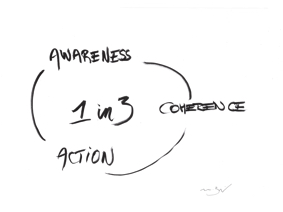Let's see explanations
This diagram shows one and the same thing : the act of conscience. It can be read clockwise or counterclockwise, both are possible. It is most useful to understand it as one unified entity as the phrase “1 in 3” suggests. In effect, the act of conscience consists of these three principles that meld together into one.
Thus the explanation of this natural principle : the awareness of a thought touches our spirit, which is followed by an action. The action is then analyzed and evaluated by our conscience with regard to the coherence between the action and the awareness we have of this action.
Our conscience is in service of happiness in the present. This happiness which we desire is ever present. Happiness for ourselves and for others.
Note that the action can be categorized twofold : external and internal. An internal action is no less valid or real than an external one. For example, a simple thought following the excitation of a whim, such as the amazement before a majestic and magnificent view of the Mont Blanc, is an action unto itself and is beholden to the same internal examination of coherence. With internal actions, the likelihood of incoherence is minimal. It is thus a private, intimate act, but it exists nonetheless. It is like awakening from sleep and saying to oneself : “well, there’s the alarm.”
The action is external in all other cases, when it expressed in physical form (words, writing, reading, actions which call attention to themselves and thus invite scrutiny, and others), even when it is done in private and for private purposes.
The public external action – we can say, a manifest and social action – is also beholden to the internal analysis of coherence, with the added element of feedback. The feedback is internal as well as external, emanating from others in our society in the form of acknowledgment and reaction to our action.
The feedback mechanism is a well-known biological phenomenon : for example, it can consist of the release of a certain hormone following the reduction in its gland activity, which in turn re-adjusts and corrects its levels.
I am aware, I commit an act, and I subsequently subject the action to the internal analysis of coherence between awareness and act. If there is incoherence, the conscience flares up and attempts to make the action correspond more perfectly to what would be an ideal action. If there is coherence, the conscience takes pleasure in this seamless mechanism. The feedback contributes to discernment, that is, making a distinction between what is good and what is bad for oneself.
Awareness is an important factor. Let us describe it : If an intuition is spontaneously brought about – as when a particle of matter appears according to quantum physics – through a thought, then this intuition, which is nurtured by the 1 in 3 mechanism we are describing, is developed and broadened, particularly if the feedback is positive. If the feedback is negative, the intuition disappears, as quantum particles would if annihilated by anti-matter. The positive feedback, which spells out “coherence”, thus causes this intuition to expand and contemplate, even admire itself, and to become the 1 in 3, a perfect action of conscience.
We can say this another way : Intuition / a thought is established by and through contemplation of itself in our mind. At this moment, it becomes an awareness. Awareness is thus the succession and result of these interwoven and inseparable phenomena.
For this natural system to function, a particular environment is necessary : inner peace. Inner peace must prevail for the conscience to function properly.
A valid human conscience is recognized by the peace that it brings to its host and those around him. We emphasize here that there is no real and lasting peace without Justice, which is its precedent and seat.



